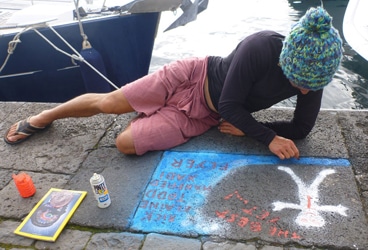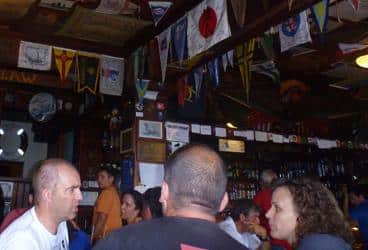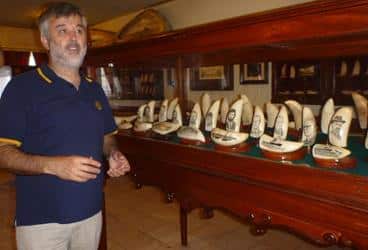
Flyer in Horta
Faial, one of the nine islands of the Azores, may not be the biggest in the group, but for the roughly 1,500 boats that annually make landfall at this North Atlantic port of call, its significance can’t be overlooked.
Part of its prominence in the annals of world wars, air travel, and communication is due to the small waterfront city of Horta, whose centuries old seafaring tradition, from before the whaling era to present, makes it a significant harbor of refuge for any boat (and in its day, seaplane) making an ocean passage.
It’s that reputation, which I learned of in accounts by bluewater sailors of yesterday and today, that filled me with a strong desire to get to the island by boat and experience it myself.
“Only those who have seen the Azores from the deck of a vessel realize the beauty of the mid-ocean picture,” wrote singlehander Joshua Slocum, who made landfall there in 1895 aboard Spray.
Slocum appreciated the lush green of cultivated fields; others valued the varied and vibrant shades of blue from hydrangeas in bloom in June and July, a quality that has earned Faial the moniker the Blue Island.
Describing the Blue Island and the other eight volcanic isles as a delightful destination in an article for Cruising World in 1991, circumnavigator Jimmy Cornell also noted of Faial that “sailors are notoriously superstitious and legend has it that it is unlucky to set sail again without recording your name on the Horta seawall.”
All this ran through my mind as we made landfall in Faial recently aboard the Swan 57 Flyer, and if images and words convey as much directive as a shopping list, I am thrilled to report, thanks to the stunning natural beauty we found everywhere and the welcoming generosity of the locals, the spree was a complete and overwhelming success.
Just as no sailor dare depart Horta without painting her boat’s name on the seawall, no salt arrives in Horta without a stop at the renown Café Sport (www.petercafesport.com). After handing a blue Cruising World 40th anniversary cap to Jose Henrique Azevedo, 4th generation of the family who started the bar that is so much more than a drinking establishment, our crew was invited to lunch at the café and a tour of the second floor, which contains the scrimshaw museum that Jose and his father, Jose, established.

These days, Café Sport attracts sailors and others who come to the Azores for all types of outdoor adventures, from climbing to cycling and diving.
In reflecting over the success of the Café Sport brand, which also now operates in Lisbon, on mainland Portugal, as well as on the other islands, and has expanded to include whale watching and other types of recreational tours, Jose explained that it evolved out of a real need.
“1918 was the first Café Sport,” he said. “It was called Café Sport because of my grandfather’s love of sports. And it became a resource for those coming from sea. We called them adventurers, not yachtie people: Tabarly, Chichester, Moitessier.
“We helped sailors who made landfall here, and ultimately Café Sport became a place where sailors could exchange money, get laundry done, receive and send mail, obtain medical assistance. It was open from 8 a.m. to 2 a.m. Better to read letters with a cold beer in hand than stand in line at the post office.”

Jose Henrique Azevedo gives a tour of the vast holdings of whale teeth, ivory, and bone at the Scrimshaw Museum.
The museum, open to the public, offers guided tours of an extensive display of intricate artwork engraved in sperm whale teeth, ivory, and bone. Glass cases contain work done aboard whaling ships centuries ago as well as pieces done by Azorean artists on land after local whalers, who hunted from open boats kept on shore, returned with a catch. While Azevedo prizes the valuable holdings he showed us, he made clear his feelings about whaling as an industry that took from the islanders as much as it gave: “The whaling life was the worst life.”
With that, we bid farewell, toured the island in a rental car, saw the spectacular sights, breathed in the fresh air and beheld the green fields and blue hydrangeas. And before we shoved off, we noted Flyer‘s arrival, crew, and passage in a painting on the waterfront — for good luck, of course.
Track Flyer at www.cruisingworld.com/flyer








